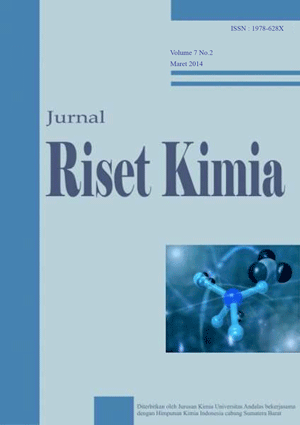PRODUKSI BIOETANOL DARI SAMPAH DEDAUNAN SEKITAR KAMPUS UNAND DENGAN METODE SSF (SIMULTANEOUS SACHARIFICATION FERMENTATION)
DOI:
https://doi.org/10.25077/jrk.v7i2.173Abstract
Vol 7 No 2
ABSTRACT
In this research, cellulose from waste leaves are conversed into ethanol by SSF technology
using cellulase from Trichoderma viride strain T1 sk. In saccharification process, cellulase
breaks cellulase polymer into glucose. Simultaneously, the formed glucose is conversed into
ethanol by invertase produced by Saccharomyces cerevisiaewhich is grew on YPD medium.
Waste leaves are pretreatmented using basic solutions : basic NaOH 1 %, NH4OH 8 %, NaOH 1
% + NH4OH 4 % and NaOH 1 % + NH4OH 8 % with ratio of solid mather (sample) : liquid
(basic solution) 1:10 (w/v) with volume of basic solution 100 mL. Immersion time is variated
for 24, 48 and 72 hours on 500C. The result of research shows that the use of NaOH 1% +
NH4OH 4% gives the highest glucose concentration 933,75 μg/mL with immersion time for 72
hours on 500C. After being pretreatmented, sample of 0,4 g waste leaves produce the highest
glucose concentration. Measurement by GC/MS shows ethanol concentration 62,41% on
fermentation time 96 hours with volume of ethanol 2,45 mL for 0,4 g sample.
Keywords : Waste leaves, Pretreatment, Trichoderma viride strain T1 sk, SSF, Bioethanol
References
Handayani SU. Pemanfaatan Bioethanol Sebagai Bahan Bakar Pengganti Bensin. Jurnal Teknik UNDIP, 99-102, (2008).
Kusnadi, Syulasmi, Ammi, Adisenjaya, dan Yusuf Hilmi. Pemanfaatan Sampah Organik Menjadi Bahan Baku Produksi Bioetanol Sebagai Energi Alternatif. Laporan Penelitian Strategis Nasional. Universitas Pendidikan Indonesia, (2009).
Duwi Suksewati, Dini. Karakterisasi Sifat Fisik dan Kimia Minyak Hasil Pirolisis Lambat Campuran Sampah Kertas dan Daun. Tugas Akhir Jurusan Teknik Mesin Universitas Sebelas Maret; Surakarta, (2010).
Rizaldi, Rizky. Pengelolaan Sampah Secara Terpadu di Perumahan Dayu permai Yogyakarta. Tugas Akhir Jurusan Teknik Lingkungan Universitas Islam Indonesia; Yogyakarta, (2008).
Z. Zuo, S. Tian, Z. Chen, and J. Li, Soaking Pretreatment on Corn Stover for Bioethanol Production Followed by Anaerobic Digestion Process. Appl Biochem Biotechnol, 167: 2088-2102 (2012).
S.S. Pramono, Studi Mengenai Komposisi Sampah Perkotaan di Negara-negara Berkembang. Universitas Gunadarma; Jakarta (2004).
Ida Bagus W G, W R A, Ida Bagus N S D. Produksi Selulase Kasar dari Kapang Trichoderma viride dengan Perlakuan Konsentrasi Substrat Ampas Tebu dan Lama Fermentasi. Jurnal Biologi, XV(2): 29-33, (2011).
H McNair, M & E J Bonelli. Dasar Kromatografi Gas. Penerbit ITB: Bandung.
Nugraha N. Pengaruh Penambahan Inokulum Jamur Hasil Isolasi dari Sampah Organik terhadap Kecepatan Waktu Pengomposan Sampah Organik Secara Aerobik. Skripsi sarjana pada FPMIPA UPI Bandung: tidak diterbitkan, (2008).
Octavia S, Tatang H, Soerawidjaja, Purwadi R dan IDG Arsa Putrawan. Pengolahan Awal Lignoselulosa Menggunakan Amoniak untuk Meningkatkan Perolehan Gula Fermentasi. Jurnal ISSN, B13(2)- B13(6): 1693 – 4393, (2011)
Kumar R, dan Wyman C E. Cellulase Adsoption and Relantionship to Feature of Corn Stover Solid Produce by Leading Pretreatment. Biotechnology and Bioengineering, 103: 252-267, (2009)
Alriksson, Bjorn. Ethanol From Lignocellulose: Alkali Detoxification of Dilute-Acid Spruce Hydrolysates. Sweden: Karlstad University Faculty of Technology and Science Biochemistry, (2006).
Graeme, M. Walker. Bioethanol: Science and Technology of Fuel Alcohol. Scotland: University of Abertay, (2010).
E. Susanti. Komparasi Teknik Sakarifikasi dan Fermentasi Simultan (SFS) dengan Hidrolisi dan Fermentasi Terpisah (HFT) pada Pembuatan Bioetanol dari Ubi Jalar Putih (Ipomoea Batatas L). Universitas Malang, (2008).
Downloads
Published
How to Cite
Issue
Section
Citation Check
License
Please find the rights and licenses in Jurnal Riset Kimia (J. Ris. Kim). By submitting the article/manuscript of the article, the author(s) agree with this policy. No specific document sign-off is required.
1. License
The use the article will be governed by the Creative Commons Attribution license as currently displayed on Creative Commons Attribution 4.0 International License.Â
2. Author(s)' Warranties
The author warrants that the article is original, written by stated author(s), has not been published before, contains no unlawful statements, does not infringe the rights of others, is subject to copyright that is vested exclusively in the author and free of any third party rights, and that any necessary written permissions to quote from other sources have been obtained by the author(s).
3. User Rights
Under the Creative Commons license, the journal permits users to copy, distribute, and display the material for any purpose. Users will also need to attribute authors and J. Ris. Kim on distributing works in the journal and other media of publications.
4. Rights of Authors
Authors retain all their rights to the published works, such as (but not limited to) the following rights;
- Copyright and other proprietary rights relating to the article, such as patent rights,
- The right to use the substance of the article in own future works, including lectures and books,
- The right to reproduce the article for own purposes,
- The right to self-archive the article,
- The right to enter into separate, additional contractual arrangements for the non-exclusive distribution of the article's published version (e.g., post it to an institutional repository or publish it in a book), with an acknowledgment of its initial publication in this journal.
5. Co-Authorship
If the article was jointly prepared by more than one author, any authors submitting the manuscript warrants that he/she has been authorized by all co-authors to be agreed on this copyright and license notice (agreement) on their behalf, and agrees to inform his/her co-authors of the terms of this policy. J. Ris. Kim will not be held liable for anything that may arise due to the author(s) internal dispute. J. Ris. Kim will only communicate with the corresponding author.












